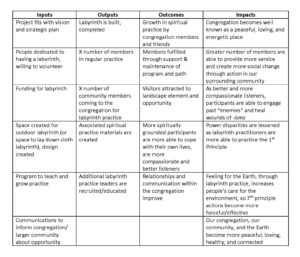I was recently working with a congregation and asked them about the ultimate impacts the congregation was trying to achieve; what they wanted to reach for in the future. They struggled with the question, telling me about the challenges they were having at the time – mostly with space constraints.
Through my work with them, I found out they had a special fund set up to create a labyrinth. It seems that in a previous location there had been a labyrinth, a number of members were involved in walking labyrinths as a spiritual practice, and there was hope to build another one in the future. When they talked, the discussion was mostly about the space to set up a labyrinth – and it struck me there was so much more to their hopes than that. So I used the labyrinth as an example about the difference between inputs, outputs, outcomes, and impacts. I put the labyrinth example showing the difference between these terms in a chart, which is included below.

When planning, many people – and particularly leaders – focus on the inputs and outputs to their endeavors. That is reasonable, because lay leaders are the ones who have to gather the resources to make something happen, yet the real goals are the outcomes and the impacts. If you start with the impacts your congregation hopes to achieve, your planning for inputs will be more effective. A basic tenant of planning is, “Start with the end in mind!”
This is important for the gathering of resources to make things happen. Donor studies show that people are seeking to make a real difference with their charitable donations. They will give you more of their time, intelligence, and money if you can tell them how a project will make the world a better place. Providing a plan that looks toward impacts, and shows what is needed to achieve them, will engage and inspire people much more than talking about how land might be cleared to make space for a labyrinth.
[Tweet “A basic tenant of planning is, “Start with the end in mind!””]
Perhaps just as importantly, people who are not engaged in lay leadership are generally not very concerned with how to get something done. After all, they are not tasked with doing it. They are more interested in what will happen when it is completed. If you want to engage your whole constituency; envision, articulate, and communicate the ultimate outcomes and impacts you hope to achieve. That will really inspire their generosity.
Here is a chart that shows the inputs, outputs, outcomes, and impacts that might result from a project to create a labyrinth. Think about this in relation to a project you are trying to get done in your own congregation. Have you articulated and communicated the impacts you are trying to achieve? If not, work with your leadership to create a chart of your own, based on this one:
Mark Ewert is a stewardship consultant with the Stewardship For Us team. Mark can be reached at mewert@stewardshipforus.com, via the UUA’s Congregational Stewardship Network, (http://www.uua.org/finance/fundraising/index.shtml), or through your regional staff.

Mark Ewert is a stewardship consultant, a Chartered Advisor in Philanthropy® (CAP®), and a professional leadership and philanthropy coach (PCC) certified with the International Coaching Federation.
His experience includes founding a nonprofit, working as a fundraiser, and leading a national organization. Reach Mark at Team@StewardshipForUs.com


Nicely said, Mark! We can never stress to often, “Begin with the end in mind!”
I think this is an interesting process, and I agree that any method we can use to help us define our needs in terms of benefits (impacts) is helpful, but at the end of the day, did they figure out where to put the labyrinth?
Hi Linda, This congregation has outgrown their current home, so are looking for larger property and building. The labyrinth is not at the top of their needs list. The example was useful for them, because they had an interest and knowledge in labyrinths, yet it was an issue they could look at objectively (not an urgent, critical issue).